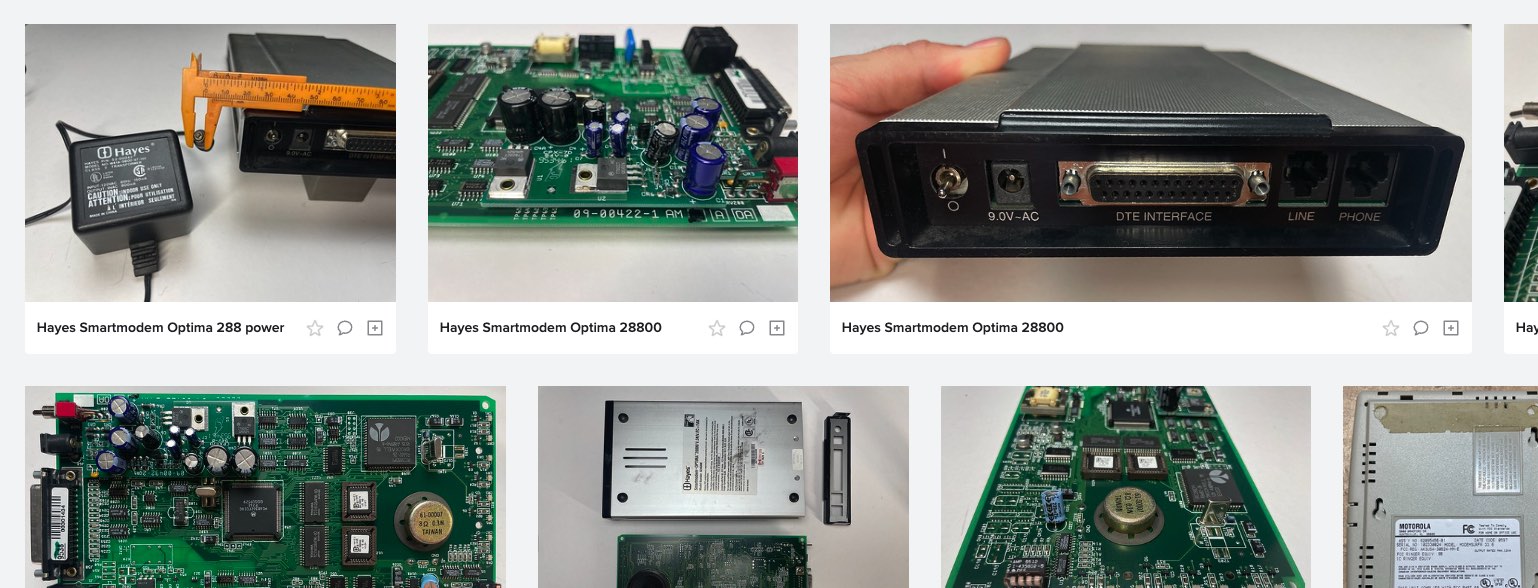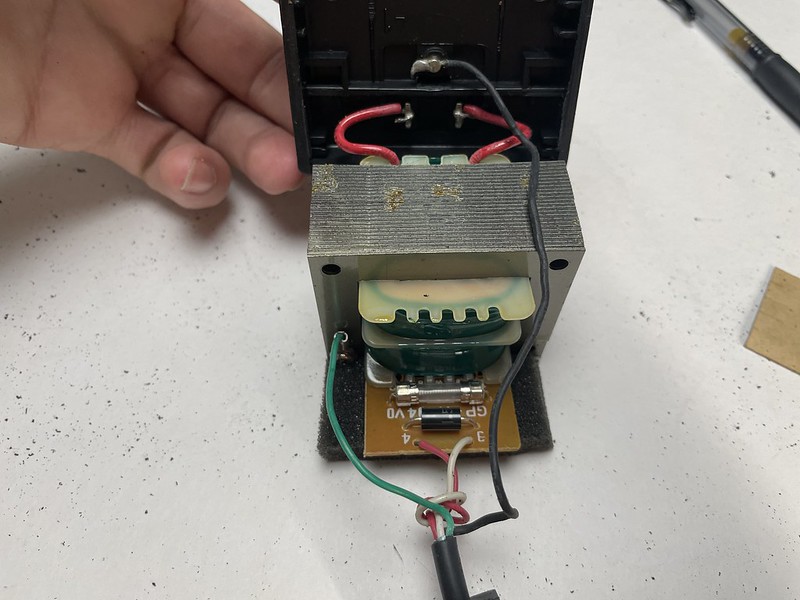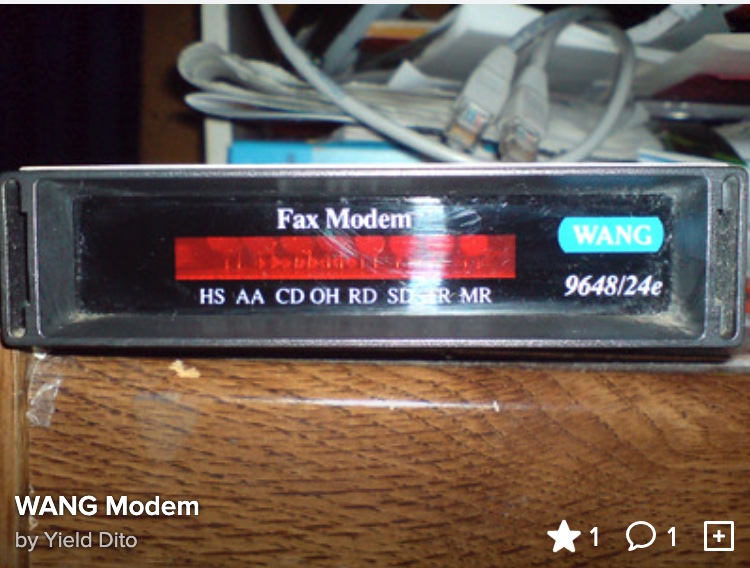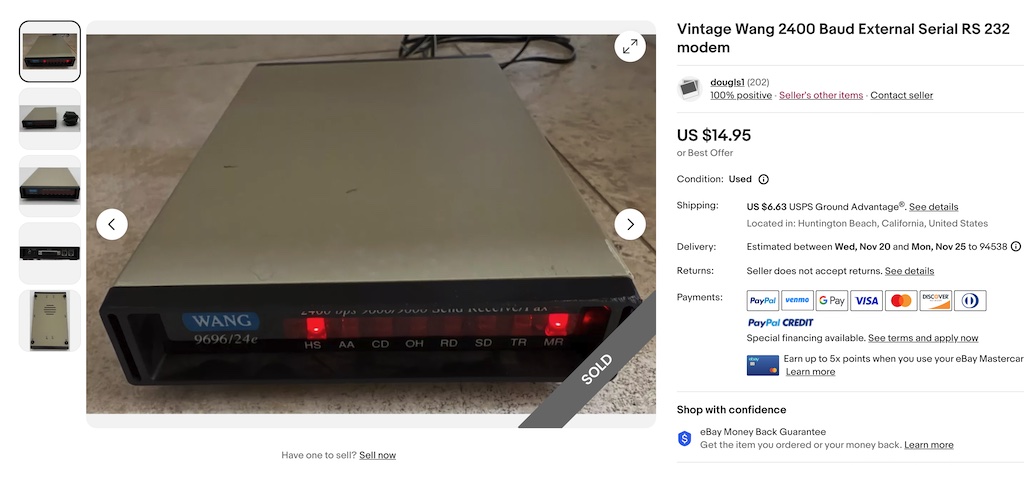[photos: flickr – Vintage dial-up modem teardowns]
[photos: flickr – Analog telephone adapters]
For several months I’ve been buying old popular models of dial-up modems from the 1990s to test how they fare over VoIP connections along with different analog telephone adapters. To my great annoyance maybe a quarter of them didn’t include an AC power adapter, so I had to do a bunch of sleuthing to figure out if the modem took AC or DC power, the voltage, the expected amperage, what type and size of power connector. What worked for one model is no guarantee it works for another similar one.
For instance even between my USR Courier V.Everything modems, models 1868, 2806, 3453C, they came with AC step-down transformers that output 20 VAC, 9 VAC, or 15 VAC. The USR Courier I-modem AC adapter claims it has a 20 VAC output, but after getting weird output measurements on the pins, I cut open the the impossible-to-find AC transformer to find it has a diode which seems to imply it’s outputting half-wave rectified DC-ish power and a much easier to find DC-only supply might work.
It looks like Retro Web doesn’t allow for documentation of external devices like modems, there’s no good collection of this information that I’m aware of. To help future generations avoid this problem, I started photographing and noting the details of every power supply in my collection. And for history’s sake I decided to open up the modems and make high-quality-ish photos of them too. Hopefully this will let people find cheap replacements for modems they buy or in the case of the Courier I-modem, find a workaround replacement because they are very rare.
At least one, such as the first gen USR Courier I-modem, had leaking electrolytic capacitors so I’ve taken extra photos of the caps to get size information. Unfortunately I am not yet an expert on circuit design, DSPs, and ROMs, so I don’t have much illuminating commentary or stories to tell about these modems.
For now I have all the teardown photos in a single, large Flickr album, organized by modem name/model.
I haven’t decided how I want to organize these, if I want to put together a modem wiki over on Tuxedocatbbs.com, or go for a more structured approach like Retro Web did. I have more information that goes along with them, either manuals I’ve scanned or dug up, replacement capacitor sizing, along with init strings used during my testing.
As for the testing itself, that’s a whole ‘nother post. I used Qmodem on my 486 to make thousands of calls to my BBS and do a 64 KB Ymodem download. For actually calling, handshaking, and connecting, surprisingly all of the modems have almost a 100% success rate over VoIP without any speed restrictions. Disabling V.92 quick connect is usually the only tweak I’ve had to make. However actually trying a download is where things start telling different stories and results vary widely. Preliminary test data and results are over on the BBS website: https://tuxedocatbbs.com/stats/ccr.txt
As of 11/2024 I have these modems up:
- Cardinal 28.8k V.34 external 020-0458
- Hayes Smartmodem Optima 9600 “Optima 96” 2003 AM
- Hayes Smartmodem 2400
- Hayes Smartmodem Optima 28800 “Optima 288” 5240AM
- Motorola ModemSURFR 33.6
- Motorola Premier 33.6
- MultiTech MultiModem II MT1432BA
- MultiTech MultiModem II MT2834BA
- MultiTech Multimodem MT5634ZBA
- SupraFAXmodem 144 LC
- SupraFAXmodem 288
- SupraFAXmodemPlus 2400
- Telebit Netblazer PN V.32bis
- US Robotics 56k V.90/x2 (basically Sportster)
- US Robotics USR5637 USB
- US Robotics Courier 56k Business Modem 3453C
- US Robotics Courier I-modem ISDN with V.Everything
- US Robotics Courier I-modem with ISDN/V.34
- US Robotics Courier V.Everything 1868
- US Robotics Courier V.Everything 2806
- US Robotics Sportster 56k with x2
- Viva 9600/4800 2400 bps data fax
- Zoom VFX V.32bis
As of 8/2025 these modems were added:
- Apple Modem 1200 (Apple II era)
- Askey V1428VQE, this is usually just branded as a generic no name 28.8k/33.6k modem but has a Rockwell chipset
- Boca Research Bocamodem 14.4k M1440E
- Cardinal V.34 with Voicemail 020-0480
- Hayes Smartmodem 1200
- Hayes Smartmodem Optima 14400 “Optima 144”
- Hayes V-series Smartmodem 2400
- Practical Peripherals PM14400FXSA V.32bis
- SupraFAXmodem V.32bis (14,400 bps with LED readout)
- US Robotics Courier HST 0093 “wide body” (HST 14,400, 1988 and 1989 board revs)
- US Robotics Courier V.32 bis with ASL 9406
- US Robotics Courier V.Everything 1224
Also worth noting that as of 8/2025 manuals for these modems are scanned and up on Internet Archive:
- Boca M1440IW/M1440EW 14.4k modem manual
- Boca Bocamodem V.34 Modem manual
- Cardinal MVPV34XV external 33.6k manual
- Hayes Smartmodem Optima Users Guide
- Hayes V-Series Smartmodem 2400 User’s Guide
- 3com/US Robotics Courier I-modem documentation CD
- Motorola Premier 33.6 modem manual
- Supra modem (Supra FAXmodem 14.4k, 28.8k) manual
- US Robotics Courier HST manual 1988 1.015.282
- US Robotics Courier V.Everything 1868 manual
- US Robotics Auto Dial 212A manual
- US Robotics Sportster user’s guide 1993
- ViVa Modem / Message Center / ViVa 24 manual
Have you seen this modem?
One of my very first modems was a Wang 9648/24e, a 2400bps fax/modem that I bought at Walmart around 1993. I have only found exactly one photograph of this model on the Internet. Barely anyone seems to remember Wang, much less that Wang made modems. It wasn’t particularly good nor bad, just a pokey 2400. I even used it for years during the ISP for credit card batch processing because higher speed modems had problems connecting to the processor. I tossed mine years and years ago, but if you come across one send it to me! I thought the Viva 9600/4800 was a rebranded version but after buying one it only looks vaguely similar and is most definitely nowhere near the same thing.
Update: 9:17 PM
Literally hours after I posted these, one just sold on eBay three hours ago! I’ve been keeping an eye out for it but guess I didn’t have a saved search for it.
Update 9:20 Oh it’s actually a 9696/24e which I’ve actually never heard of and looks slightly larger, so not exactly the same, but still so close!



